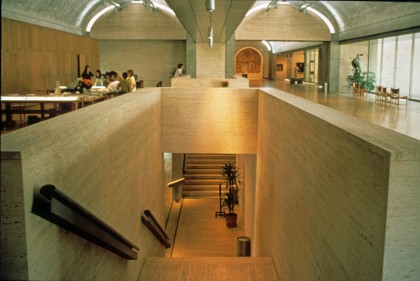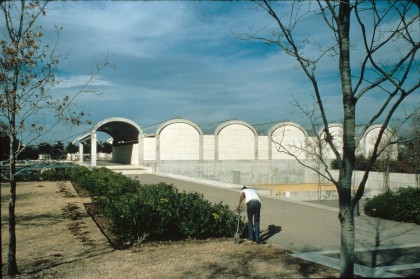Kimbell Art Museum
 The story of the success of the Kimbell Art Museum begins, not with the hiring of its esteemed architect in 1967, but two years earlier when the trustees of the Kimbell Foundation appointed Dr. Richard F. Brown as director of the budding museum. Industrialist Kay Kimbell had bequeathed his personal collection of more than 350 art objects from which the museum’s holdings would grow. He had also provided the capital funds necessary for a strong acquisitions program as well as a home for the museum. Brown’s challenge from the trustees was to build both a collection and a building that would distinguish the Kimbell Art Museum as one of the finest institutions of its size in the country.
The story of the success of the Kimbell Art Museum begins, not with the hiring of its esteemed architect in 1967, but two years earlier when the trustees of the Kimbell Foundation appointed Dr. Richard F. Brown as director of the budding museum. Industrialist Kay Kimbell had bequeathed his personal collection of more than 350 art objects from which the museum’s holdings would grow. He had also provided the capital funds necessary for a strong acquisitions program as well as a home for the museum. Brown’s challenge from the trustees was to build both a collection and a building that would distinguish the Kimbell Art Museum as one of the finest institutions of its size in the country.
Brown had stipulated, before accepting the post of director, that he should have full control of architect selection and client input in the building’s planning. In preparation for this task, he assembled a lengthy and detailed pre-architectural program which described specific qualities of the place he envisioned.
He understood his Fort Worth clientele well. He realized that a well-built, beautiful building which was, in itself, a work of art could be a drawing card – a powerful entrée into the Texas art world. He knew that the most basic and potent appreciation of art derives from its appeal to people’s senses. He observed, “The overwhelming percentage of people whom this building is intended to serve will not be art historians, other architects or progressive artists with a sophisticated background in architectural form. Their total experience of a visit to a museum should be one of warmth, mellowness, and even elegance…. A visitor to an art museum ought to be charmed; otherwise, why should we expect him to come?” (Brown, “Kimbell Art Museum Pre-architectural Program,” June 1, 1966).

Brown drew a verbal picture that described an atypical museum for the times. He had rejected the bland box interiors of the recent Whitney Museum, the Los Angeles County Museum, and the Museum of Modern Art additions. He said, “Museum people have been after closed, dark rooms so they can paint the walls white, light them with artificial light, and control the situation. But by having control of the situation, they don’t realize their system has control of them.” He was adamant about the vital role of natural light, observing, “We are not after a measurable physical quantity, or a physiological reaction; we are after a psychological effect through which the museum visitor feels that both he and the art he came to see are still a part of the real, rotating, changeable world” (“Kahn’s Museum: An Interview with Richard F. Brown,” Art in America, September 1972, p. 45).
In the summer of 1966, pre-architectural program in hand, Richard Brown began to interview a distinguished list of architects for the job. He selected Louis I. Kahn because he thought Kahn would “approach the problem like Adam, for the first time.” He found Kahn “willing to let the specific situation posed by the creation of a building guide him and tell him what the structure, engineering and esthetic ought to be” (“Kahn’s Museum”). At least in this instance, it seems Brown was right. The Kimbell Museum pays startling allegiance not only to the director’s well-defined program, but also to particulars of site, climate, and regional character. Its ruggedness, flatness, tawny naturalness of surface and color, and especially the way it copes with the sometimes brutal sun make it part and parcel of where it is.
In so responding to this specific situation, Kahn created a building that is something of an enigma relative to his other works. From his earliest conceptual sketches the scheme seemed to draw on previously untapped sources of form in Kahn. The repetitive series of linear vaults emerged quite early in what was to be a long design process. Their origin is a point of considerable conjecture among Kimbell aficionados. Wherever they originated, it seems clear by their great success and sophistication that their selection was not meretricious. They are the essence of the building.
It is the vaults that give the building its loftiness as well as its intimacy; the vaults that light the space with their silvery, luminescent glow; the vaults that make the “rooms” of the building while at the same time providing the flexibility of uninterrupted clear spans. It is the nonhierarchical vaults that give the building its order and rhythm, injecting character into an otherwise undistinguished massing and solving the problem of the fifth façade, the roof, which is visible from the hill above.
It is the vaults that lock the building onto its site, paralleling a double row of former street trees that frame the museum park to the west. And it is the vaults, again, that open graciously to make a triple porch on the park façade, intimating the arcade of the trees a few yards away. The vaults, executed as they are in smooth, lustrous concrete, create a mystical presence in the building, generating a feeling of timelessness and peace. They are a magical device.
It is standing under one of those vaults that one can best sense the art and poetry of Louis Kahn-Kahn the philosopher, Kahn the mystic, Kahn the craftsman, Kahn the connoisseur, Kahn the architect. His was a sensual art, full of emotion and sentiment. He was a modern romantic. His Kimbell Art Museum speaks the language of human experience. It is a building to touch and feel-pocked satin of travertine alongside the mottled “liquid stone” of concrete, honey-colored oak against cool blue stainless steel – and everywhere a magic glow of light borrowed from the sun.